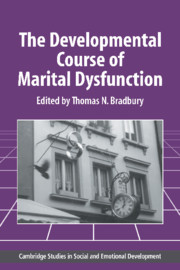Book contents
- Frontmatter
- Contents
- List of Contributors
- Foreword
- Introduction: The Developmental Course of Marital Dysfunction
- Part I Conceptual and Empirical Contributions
- 1 Communication in Early Marriage: Responses to Conflict, Nonverbal Accuracy, and Conversational Patterns
- 2 Marital Aggression, Quality, and Stability in the First Year of Marriage: Findings from the Buffalo Newlywed Study
- 3 Accommodation Processes During the Early Years of Marriage
- 4 The Psychological Infrastructure of Courtship and Marriage: The Role of Personality and Compatibility in Romantic Relationships
- 5 Happiness in Stable Marriages: The Early Years
- 6 Developmental Changes in Marital Satisfaction: A 6-Year Prospective Longitudinal Study of Newlywed Couples
- 7 The Development of Marriage: A 9-Year Perspective
- 8 Premarital Predictors of Relationship Outcomes: A 15-Year Follow-up of the Boston Couples Study
- 9 Optimizing Longitudinal Research for Understanding and Preventing Marital Dysfunction
- 10 Socialization into Marital Roles: Testing a Contextual, Developmental Model of Marital Functioning
- 11 Physical Aggression in Marriage: A Developmental Analysis
- Part II Invited Commentaries
- Author Index
- Subject Index
7 - The Development of Marriage: A 9-Year Perspective
Published online by Cambridge University Press: 13 October 2009
- Frontmatter
- Contents
- List of Contributors
- Foreword
- Introduction: The Developmental Course of Marital Dysfunction
- Part I Conceptual and Empirical Contributions
- 1 Communication in Early Marriage: Responses to Conflict, Nonverbal Accuracy, and Conversational Patterns
- 2 Marital Aggression, Quality, and Stability in the First Year of Marriage: Findings from the Buffalo Newlywed Study
- 3 Accommodation Processes During the Early Years of Marriage
- 4 The Psychological Infrastructure of Courtship and Marriage: The Role of Personality and Compatibility in Romantic Relationships
- 5 Happiness in Stable Marriages: The Early Years
- 6 Developmental Changes in Marital Satisfaction: A 6-Year Prospective Longitudinal Study of Newlywed Couples
- 7 The Development of Marriage: A 9-Year Perspective
- 8 Premarital Predictors of Relationship Outcomes: A 15-Year Follow-up of the Boston Couples Study
- 9 Optimizing Longitudinal Research for Understanding and Preventing Marital Dysfunction
- 10 Socialization into Marital Roles: Testing a Contextual, Developmental Model of Marital Functioning
- 11 Physical Aggression in Marriage: A Developmental Analysis
- Part II Invited Commentaries
- Author Index
- Subject Index
Summary
In the past decade significant progress has been made in furthering our understanding of how marriages change over time. Much of this progress can be attributed to the availability of increasingly sophisticated theoretical models and the development of methodological strategies to test them. The relatively recent empirical shift from cross-sectional, descriptive studies to longitudinal studies, in addition to the increasing emphasis on the observational study of dyadic interaction, have brought the study of marital relationships to a new level (Bradbury & Karney, 1993; Notarius & Markman, 1981). Clearly, the most significant advantage of using longitudinal data is that they permit a more stringent examination of causal hypotheses. In addition, by observing and analyzing couples' interactions, rather than relying on their self-reports, questions about the processes or mechanisms of change can be examined more carefully.
In the Denver Family Development Project, originated in 1981 by Howard Markman at the University of Denver, we studied how relationship quality in a group of satisfied and committed premarital couples changed over time over the first decade of their marriages. We sought to discover what individual or relationship characteristics ultimately lead to distress, divorce, or continued happiness. In this chapter, we present some of the results of the first 9 years of our longitudinal study and discuss our successes and failures while meeting the challenges of longitudinal work.
- Type
- Chapter
- Information
- The Developmental Course of Marital Dysfunction , pp. 205 - 236Publisher: Cambridge University PressPrint publication year: 1998
- 31
- Cited by



